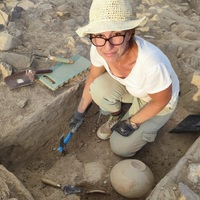Conference Presentations by Felix Ostmann

(14th May 2015, Stara Zagora) Upscaling+ the Neolithic house. Trends in house size and function in Anatolia and the Southern Balkans
Neolithic houses in Anatolia and the Southern Balkans show a marked increase in residential floor... more Neolithic houses in Anatolia and the Southern Balkans show a marked increase in residential floor space from the late 7th to the early 6th millennium BC cal. A tendency to scale up the house, without actually increasing the number of rooms, provides a common backdrop to the Neolithic in both regions. Houses revolved around one central room, which provided discrete sleeping, cooking and storage facilities. As houses became larger over time, they presumably accommodated more people and/or activities. Further west than Cappadocia, not a single Neolithic building differed markedly in shape or elaboration from contemporary residential structures, and it is safe to assume that they were for domestic use only. A few outlier rooms from Nea Nikomedeia and Sofia-Slatina (‘big house’) reached, however, dimensions of circa or slightly over 100 m2. This paper will address the function of these extra large rooms: were they still used as domestic spaces? Or did they have some sort of central/ritual function? Ongoing excavations at Çukuriçi Höyük near Ephesus, conducted under the auspices of the ERC project “Prehistoric Anatolia”, provide new insights into this issue. Indeed, on a same building level, houses varied in size on a ratio of 1:4.
Papers by Felix Ostmann

Anatolian Studies, 2016
A Neolithic structure was rebuilt three times at Çukuriçi Höyük, on the central Anatolian Aegean ... more A Neolithic structure was rebuilt three times at Çukuriçi Höyük, on the central Anatolian Aegean coast, despite its unfavourable location on unsettled fill. We draw upon this seemingly incongruous case to make inference about the siting of buildings in Neolithic times. Through detailed cross-comparison with other sequences of vertically superimposed buildings in Anatolia and the Aegean region, we retrace the contours of a Neolithic practice aimed at maintaining occupation in one place. Over time, building continuity transformed into a strategy by some households to claim authority over a place and appropriate it for their own benefit. With regard to the location of Neolithic buildings, we conclude that choices about location dominated over practical considerations. Once a commitment to place was made, there was no turning back, even when this meant living in an unstable house that needed to be rebuilt repeatedly.
Upscaling+ the Neolithic House. Trends in house size and function in Anatolia and the Southern Balkans
ABSTRACT

Journal of World Prehistory, 2015
The process of Near Eastern neolithization and its westward expansion from the core zone in the L... more The process of Near Eastern neolithization and its westward expansion from the core zone in the Levant and upper Mesopotamia has been broadly discussed in recent decades, and many models have been developed to describe the spread of early farming in terms of its timing, structure, geography and sociocultural impact. Until now, based on recent intensive investigations in northwestern and western Anatolia, the discussion has mainly centred on the importance of Anatolian inland routes for the westward spread of neolithization. This contribution focuses on the potential impact of east Mediterranean and Aegean maritime networks on the spread of the Neolithic lifestyle to the western edge of the Anatolian subcontinent in the earliest phases of sedentism. Employing the longue durée model and the concept of 'social memory', we will discuss the arrival of new groups via established maritime routes. The existence of maritime networks prior to the spread of farming is already indicated by the high mobility of Epipalaeolithic/Mesolithic groups exploring the Aegean and east Mediterranean seas, and reaching, for example, the Cyclades and Cyprus. Successful navigation by these early mobile groups across the open sea is attested by the distribution of Melian obsidian. The potential existence of an additional Pre-Pottery Neolithic (PPN) obsidian network that operated between Cappadocia/

A Neolithic structure was rebuilt three times at Çukuriçi Höyük, on the central Anatolian Aegean ... more A Neolithic structure was rebuilt three times at Çukuriçi Höyük, on the central Anatolian Aegean coast, despite its unfavourable location on unsettled fill. We draw upon this seemingly incongruous case to make inference about the siting of buildings in Neolithic times. Through detailed cross-comparison with other sequences of vertically superimposed buildings in Anatolia and the Aegean region, we retrace the contours of a Neolithic practice aimed at maintaining occupation in one place. Over time, building continuity transformed into a strategy by some households to claim authority over a place and appropriate it for their own benefit. With regard to the location of Neolithic buildings, we conclude that choices about location dominated over practical considerations. Once a commitment to place was made, there was no turning back, even when this meant living in an unstable house that needed to be rebuilt repeatedly.
Key words: Neolithization, Western Anatolia, Aegean, Maritime networks and colonization, Cukurici... more Key words: Neolithization, Western Anatolia, Aegean, Maritime networks and colonization, Cukurici Höyük











Uploads
Conference Presentations by Felix Ostmann
Papers by Felix Ostmann